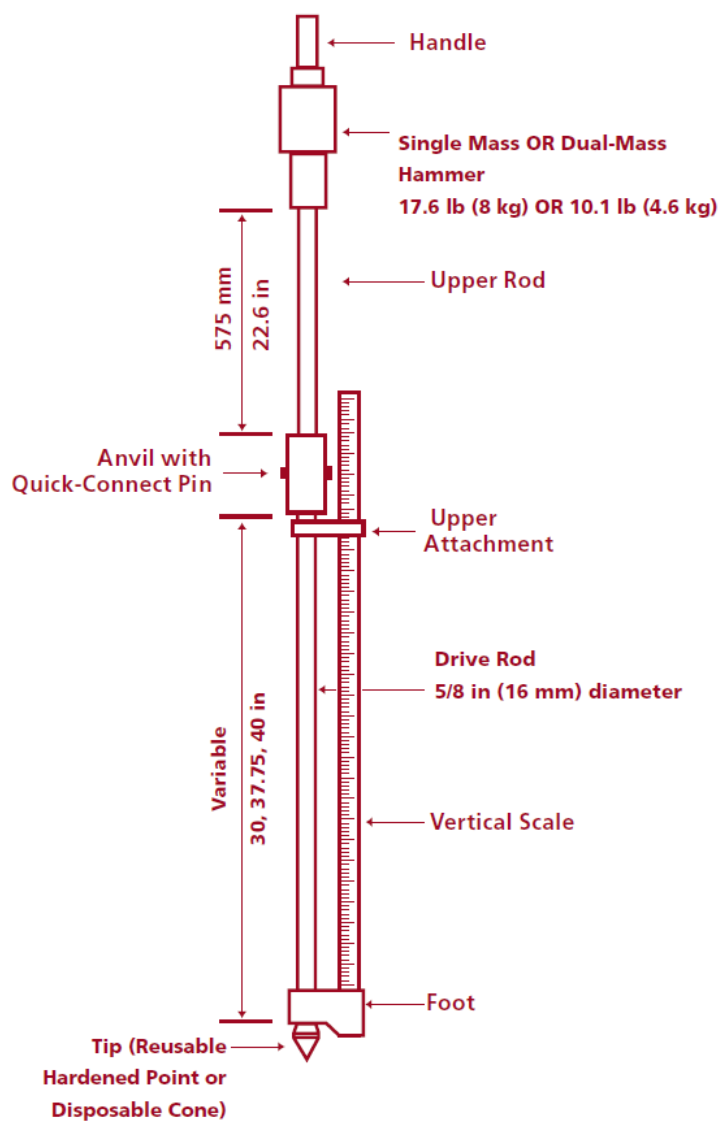Dynamic Cone Penetrometer, or DCP, is a tool used for evaluating the strength of soils on site. It also helps with monitoring the condition of granular layers and subgrade soils in pavement sections over time. It can be used to determine the right solutions for the sites, especially when soft soils are involved.
Apparatus for DCP
The apparatus of the instrument involves the following parts:
- Handle
- Top Rod
- Hammer(8kg)
- Anvil
- Handguard Cursor
- Bottom Rod
- 1m rule
- 60 degree Cone
- Tommy bars and spanners(to ensure that the screwed joints are kept tight at all times)

The following joints should be secured with a strong adhesive or similar non-hardening thread-locking compound prior to use:
(i) Handle/top rod
(ii) Anvil/bottom rod
(iii) Bottom rod/cone
The hammer is lifted to the top of the rod and released in order to drive the rod into the ground. With the help of the embedded vertical scale, the penetration(in inches or millimeters) is recorded after the blows of the hammer.
Correlations have been established between measurements with California Bearing Ratio (CBR) and DCP so that the outcome can be interpreted and compared with CBR specifications for pavement design.
Procedure
- After the instrument is set up, the zero reading of the apparatus is recorded. This is done by placing the DCP on a hard surface, ensuring its verticality, and then noting down the zero reading in the appropriate place on the proforma
- The instrument is held vertical, and the weight is carefully raised to the handle. The weight should not touch the handle before it is allowed to drop, and that the operator should let it fall freely and does not lower it with his hands.
- It is advised that a reading should be taken at increments of penetration of about 10mm. However, it is usually easier to take a scale reading after a set number of blows. It is, therefore, necessary to change the number of blows between readings according to the strength of the layer being penetrated. For good quality granular bases, readings after every 5 or 10 blows are normally satisfactory, but for weaker sub-base layers and sub-grades, readings after every 1 or 2 blows may be appropriate.
- After the completion of the test, DCP is removed by gently tapping the weight upwards against the handle. It should be done with caution as if done vigorously, the life of the instrument will be reduced.
Benefits of DCP
- Soil information is often limited, and is often collected from within the extents of the foundation area, but one may also need to assess the soils somewhere else on the site.
- Information regarding the variation of soil strength with depth can be obtained, which can be critical for developing the best solution for unsuitable subgrade soils.
- One can collect information from a lot of points relatively quickly, so you can see how soil conditions vary across the site and respond accordingly.
- One gets accurate and precise information on the soil conditions in the field and at construction time.
FAQs
- What is Dynamic cone Penetrometer?
DCP is a tool used for evaluating the strength of soils on site. It also helps with monitoring the condition of granular layers and subgrade soils in pavement sections over time. It can be used to determine the right solutions for the sites, especially when soft soils are involved. - Describe the working procedure of DCP in brief?
The DCP is a simple and portable instrument. It consists of a hardened conical tip, standard diameter steel rod, and a standard weight hammer(8kg), which is dropped from the top of the rod against an anvil to advance the tip into the ground. - What is the principle of working of DCP?
It consists of a hardened conical tip, standard diameter steel rod, and a standard weight hammer(8kg), which is dropped from the top of the rod against an anvil to advance the tip into the ground.
Source: Therconstructor










